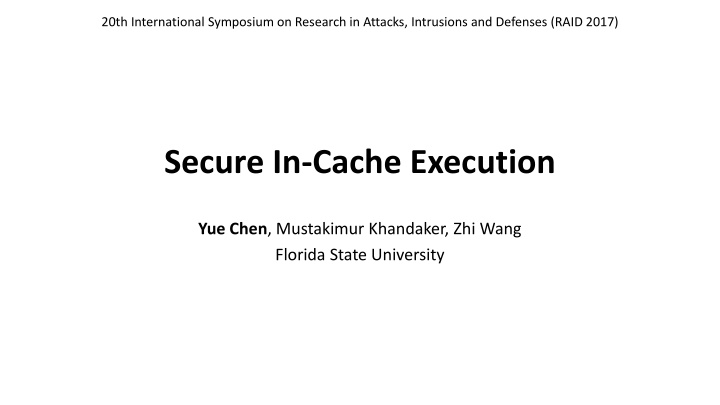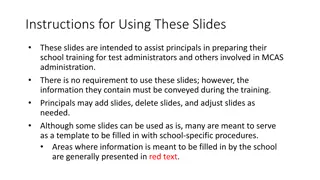
Innovative Protection Against Cold Boot Attacks
"Explore groundbreaking research from RAID 2017 on secure in-cache execution to counter cold boot attacks by preventing sensitive memory content theft. EncExec ensures data secrecy, performance isolation, and application transparency. Learn about the cutting-edge design overview and threat model addressing this critical security concern effectively."
Download Presentation

Please find below an Image/Link to download the presentation.
The content on the website is provided AS IS for your information and personal use only. It may not be sold, licensed, or shared on other websites without obtaining consent from the author. If you encounter any issues during the download, it is possible that the publisher has removed the file from their server.
You are allowed to download the files provided on this website for personal or commercial use, subject to the condition that they are used lawfully. All files are the property of their respective owners.
The content on the website is provided AS IS for your information and personal use only. It may not be sold, licensed, or shared on other websites without obtaining consent from the author.
E N D
Presentation Transcript
20th International Symposium on Research in Attacks, Intrusions and Defenses (RAID 2017) Secure In-Cache Execution Yue Chen, Mustakimur Khandaker, Zhi Wang Florida State University
Cold Boot Attack Dump memory by freezing and transplanting Steal sensitive information
Cold Boot Attack Sensitive memory content in plaintext Secret Message Memory Secret Message
Our Solution Sensitive memory content cannot be read with encryption ? ? ? Memory XXXXXXXXXXXX
EncExec: Design Goals Data secrecy Plaintext view only in cache; key protected as well Performance isolation Performance impact isolated from other processes Application transparency User program unmodified to run under EncExec
Threat Model Able to perform cold boot attacks No malware installed (e.g., kernel rootkit) Typical use scenario: Laptops lost in public places, even protected by encrypted hard disks and screen locks
Design Overview Data in memory always encrypted; decrypted into the L3 cache only when accessed Use reserved cache as a window over protected data Use L3 (instead of L1 or L2) cache to minimize performance impact
Design Overview Decrypted data will never be evicted to memory (no cache conflict) Extend kernel s virtual memory management to strictly control access Only data in the window are mapped in the address space If more data than window size -> page replacement
Design Overview Two modes: 1. Given a block of secure memory for storing critical data Need to (slightly) modify the program 2. Use reserved cache to protect all the data of the process Use the reserved cache as a moving window
Design: Key Techniques Spatial cache reservation Reserves a small part of the L3 cache for its use Secure in-cache execution Data encrypted in memory, plaintext view only in cache
CPU Cache Intel Core i7 4790 cache architecture
CPU Cache 2-way set-associative cache, 8 cache lines in 4 sets. Each cache line has 16 bytes.
Challenges: Spatial Cache Reservation Fine-grained cache control x86 transparently manages cache assignment and replacement Countermeasures: Rule 1 Protected data are only cached by the reserved cache No other memory is cached by the reserved cache Rule 2: Accessible (decrypted) protected data is less than the reserved cache size Thus, reserved cache content will not be evicted
Design: Spatial Cache Reservation Use page table to control reserved memory usage Page table can only map page-sized and page-aligned memory Reserve at least a whole page on the L3 cache Reserve a smallest page of the cache (4KB) How much space in total we need to reserve?
Design: Spatial Cache Reservation Cache *0 *0 *4 *4 *8 *8 *C *C Set 2 Set 3 Set 1 Set 0 00 04 08 0C 10 14 18 1C 20 24 28 2C 30 34 38 3C 40 44 48 4C Memory
Design: Spatial Cache Reservation Cache *0 *0 *4 *4 *8 *8 *C *C : Needs to be reserved Set 2 Set 3 Set 1 Set 0 00 04 08 0C 10 14 18 1C 20 24 28 2C 30 34 38 3C 40 44 48 4C Memory
Design: Spatial Cache Reservation Cache *0 *0 *4 *4 *8 *8 *C *C : Needs to be reserved Set 2 Set 3 Set 1 Set 0 00 04 08 0C 10 14 18 1C 20 24 28 2C 30 34 38 3C 40 44 48 4C Memory
Design: Spatial Cache Reservation Cache *0 *0 *4 *4 *8 *8 *C *C : Needs to be reserved Set 2 Set 3 Set 1 Set 0 00 04 08 0C 10 14 18 1C 20 24 28 2C 30 34 38 3C 40 44 48 4C Memory
Example: Spatial Cache Reservation Intel Core-i7 4790 L3 cache 16-way set-associative; physically indexed and physically tagged Cache line size: 64 bytes = 26bytes (offset field: 6 bits) Cache size: 8 MB Set number: 8M/(64*16) = 8192 = 213 (set field: 13 bits) If machine has 16GB (234) of physical memory, tag field has 15 bits (34 6 - 13 = 15).
Example: Spatial Cache Reservation Reserve one page (4KB) 64 cache lines in one page Page_size/cache_line_size = 4K/64 = 64 Need to reserve 64 cache sets All the cache lines in the same set reserved together (16-way) Reserve 64KB cache in total 64 (set number) * 16 (associativity ways) * 64B (cache line size) = 64KB
Example: Spatial Cache Reservation Reserve 1/128 of the physical memory 64 (reserved sets) / 8192 (total) = 1/128 Reserve one physical page for every 128 pages If RAM is 16GB, the total reserved memory is: 16GB * 1/128 = 128MB Ensure no cache eviction: Can use 64KB (16 pages) at a time of the 128MB Name these 16 pages as plaintext pages Protected data can be larger than 64KB as we use demand paging
Design: Secure In-Cache Execution Desynchronize memory (encrypted) and cache (plaintext) Cache in write-back mode Guaranteed by hardware and existing kernels (in most OS es) L3 cache is inclusive of L1 and L2 caches Guaranteed by hardware and existing kernels No conflict in the reserved cache No more protected data at a time than the reserved cache size
Design: Secure In-Cache Execution More data to protect? Demand paging Access unmapped data -> page fault Allocate a plaintext page (for securing data) If no page available, select one for replacement Encrypt the plaintext page, copy it back Decrypt faulting page into plaintext, update page table if necessary
Design: Secure In-Cache Execution Dedicate one plaintext page to store keys and sub-keys Cannot be evicted or replaced Frequent protected data encryption/decryption Use CPU built-in support to speed up cryptographic algorithms
Implementation: Spatial Cache Reservation Reserve physical pages in the booting process Modify allocators to skip reserved pages Make sure no reserved pages exist in page table Hook run-time page allocator and kernel s whole-cache flushing function
Implementation: Secure In-Cache Execution pmap is used to unmap a page Consist of architecture-specific data and functions to manage the process page table Maintain a reverse mapping for physical pages Track page usage information for page replacement Remove shared protected pages from other processes
Performance Evaluation Use the hardware-accelerated AES (AES-NI) to encrypt and decrypt data About 3 s on average to encrypt/decrypt 4KB data using 128- bit AES algorithm 6 s to replace an existing page
Performance Evaluation Mode 1: Choose data to encrypt Mode 2: Encrypt all the data Test with 15 or 31 plaintext pages Overhead of common cryptographic algorithms
Performance Evaluation Mode 1: Choose data to encrypt Mode 2: Encrypt all the data Test with 15 or 31 plaintext pages Overhead of RSA and DH handshakes
Performance Evaluation Performance of Bonnie while concurrently running the mbed TLS benchmark. The unit on the Y-axis is MB/sec or thousand_seeks/sec (for RandomSeeks only).
Q & A Secure In-Cache Execution www.YueChen.me
Compared to Intel SGX SGX is great! EncExec Works on old CPUs No time-consuming context switch Supports unmodified programs






















